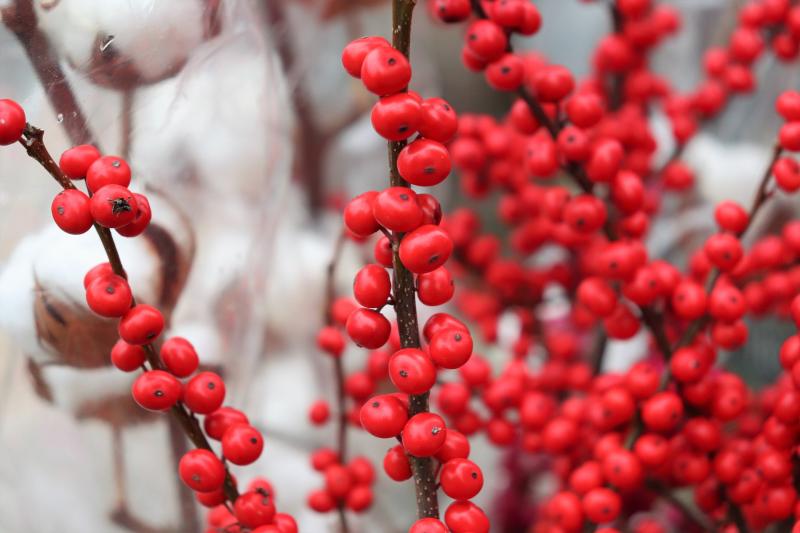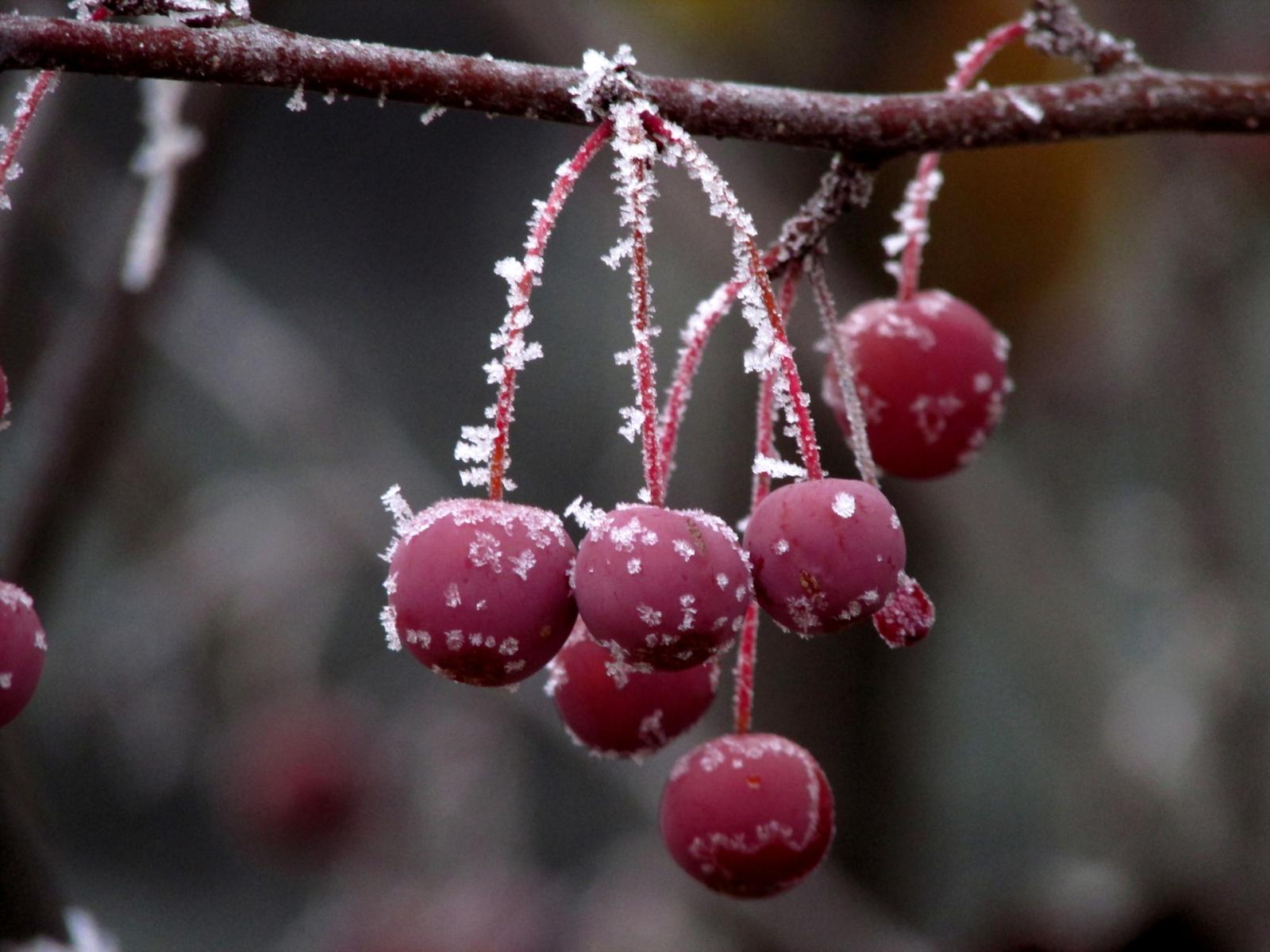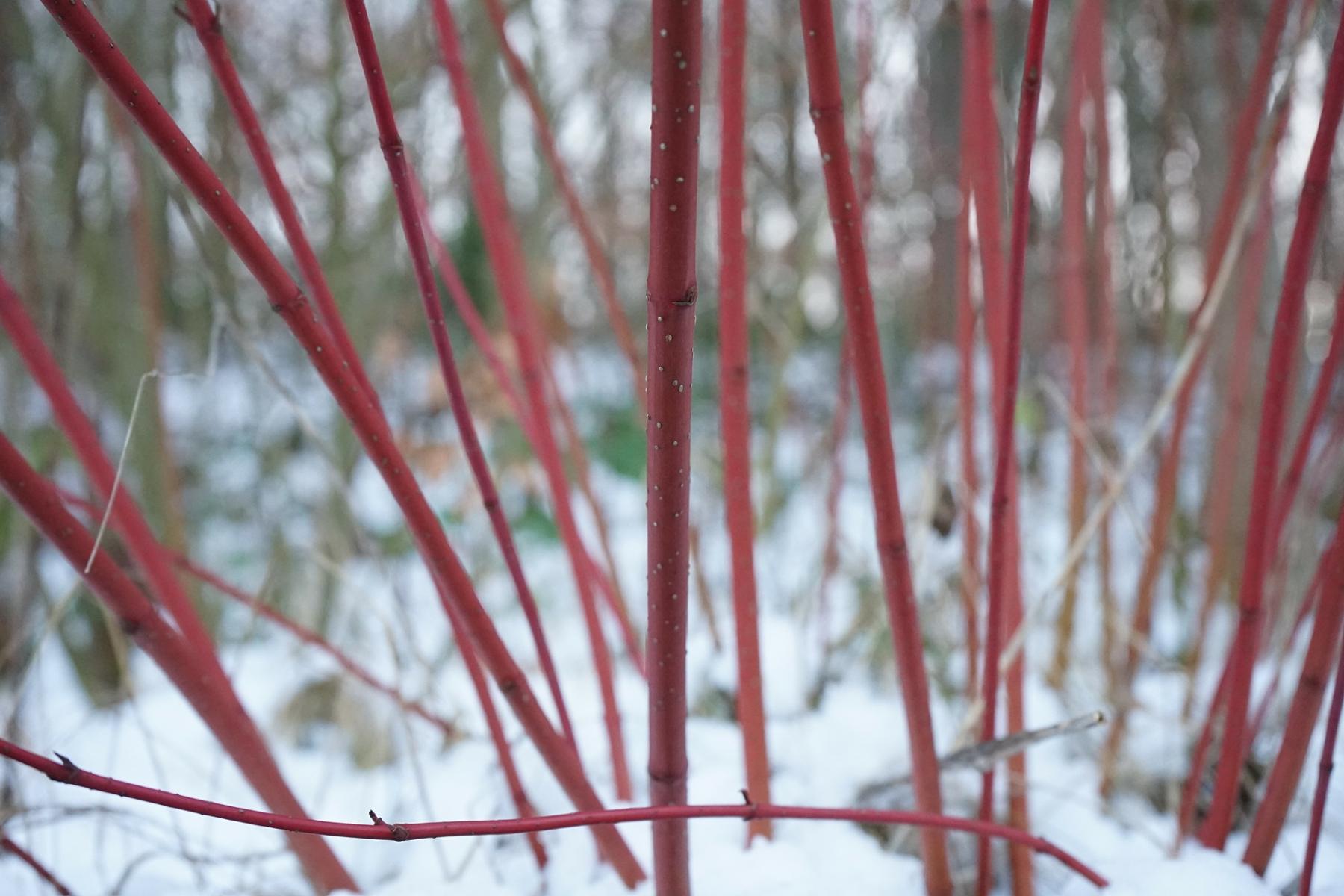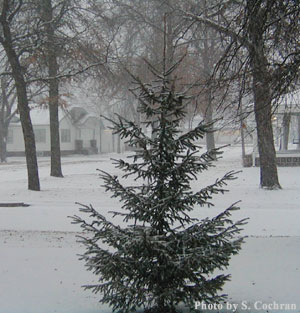
Looking out your window in January, the predominant colors you’ll see are shades of brown, gray, and, if we have snow, white. Evergreen trees and shrubs provide some relief, but the view is still pretty neutral. An excellent way to brighten the dead of winter is to plant trees and shrubs that possess colorful fruit or bark, or plants with interesting shapes. Take a look at your winter landscape now, and decide if spring planting this year should include plants for winter interest.
 Trees
Trees
While crabapples are usually planted for their flowers, many varieties also possess attractive, persistent fruit. Crabapples are not a preferred fruit by birds so stay on trees until February or March, when they attract early arriving robins or flocks of cedar waxwings. Always look for trees with good resistance to apple scab and cedar-apple rust, such as those below.
- Red fruits - Donald Wyman, Sugar Tyme, Red Jewel, David and Jewelberry
- Red-orange fruits - Indian Magic
- Yellow fruits - Winter Gold
Hawthorns are another group of small, flowering trees that possess attractive fruit. Hawthorns produce white flowers in spring. In fall, the fruit turn red and persist into winter. Two hawthorns noted for their excellent fruit display are the Washington hawthorn (Crataegus phaenopyrum) and Winter King hawthorn (Crataegus viridis 'Winter King').
 Shrubs
Shrubs
In the past, I have written about hollies that are winter hardy in Nebraska, specifically winterberry and Meserve holly hybrids. Both have attractive red fruit in fall and winter, and Meserve holly has attractive dark green leaves. Winterberry is deciduous, so loses its leaves in fall, what remains are bright red berries on bare stems that stand out against snow or winter brown landscapes.
Boxwood is another broadleaf evergreen to consider for the winter landscape. Look for winter hardy cultivars, such as Wintergreen, Chicagoland Green, Green Gem or Green Velvet. Choose a location protected from summer and winter wind. Prevent winter leaf desiccation with a good layer of winter mulch, and by providing additional winter water if conditions are dry.
Spice up your landscape with the beautifully colored stems of Redosier dogwood, Cornus sericea. These woody shrubs prefer full sun, are adaptable to many soil types, and hardy to Zone 2. They can reach 7 to 9 feet in height with a spread of 10 feet or more, so choose cultivars carefully or allow them enough space to grow well and develop a nice shape. Once established, annual removal of the oldest, thickest stems will keep height down and ensure that new, young, brightly colored stems are encouraged. Varieties of redosier dogwood with colorful stems include:
- Bailey's Red or Cheyenne- bright red stems
- Cardinal- bright cherry red stems
- Colorado- orange-red stems
- Isanti – compact form, grows 5-6 feet, with bright red stems
- Yellowtwig (Flaviramea)- chartreuse- yellow stems

Evergreens
At this time of year many of our landscapes lack interest, especially when it comes to color. Conifers fill a great void in this area because they aren't restricted to just green. Several varieties of spruce, juniper, and arborvitae possess colored foliage. These conifers differ in their ability to tolerate extremes in growing conditions. Many are cold tolerant, but are unable to withstand extreme heat. Others are heat tolerant, but unable to take colder growing conditions. Make sure the conifer you select is appropriate for your site.
Most prefer well-drained soils with a neutral to slightly acid pH. While most conifers prefer full sun, many can tolerate partial shade. Exceptions to this are golden or light-colored conifers and blue-needled cultivars. Golden or light-colored conifers prefer a site with bright, filtered light. Too much sun can severely burn and damage the needles ruining the plant. Blue-needled conifers grow best in full sun.
In most cases, nature doesn't create bad color combinations, however in some instances, we do. An effective way to used colored conifers is to select a monochromatic or single color scheme, such as using all blue-toned plant material. Monochromatic plantings create a restful atmosphere.
More striking effects can be created by selecting contrasting colors. Conifers with gold or yellow foliage planted with purple foliaged or flowering plants is an attractive combination. Other attractive combinations include orange flowers with blue colored conifers, or red flowers with green foliage. Other color combinations are attractive as well. Instead of choosing bright green foliage for use with blue conifers, select green-gray foliage instead. This gives the blue area some life. However, if only a few blue conifers are being used, the blue color jumps out when placed against a green background.
A green background for yellow plants has the same effect, creating very attractive plantings. Yellow conifers also look good when combined with gray-green or blue-green foliage varieties. An attractive natural color combination is possible when purple and green foliage is combined. To brighten up an area, use green with white or silver-leaved plants. Bicolored conifers function best when used as accents, massed in large beds, or even woven as a band of color through other perennials or shrubs.
The size and form of colored conifers varies with the genus, species, and cultivar. They range from low ground covers to medium or large sized shrubs to trees. Several fall into the "dwarf"category, because their rate of growth is slow. The most common forms are rounded or upright and broad.
Bi-color evergreens to consider for our area include the following.
- Juniperus communis 'Compressa'
- Juniperus communis 'Pencil Point'
- Picea omorika 'Nana'.
Blue varieties include:
- Juniperus communis 'Berkshire'
- Juniperus horizontalis 'Wiltonii'
- Juniperus procumbens 'Nana'
- Picea glauca 'Pendula'
- Pinus strobus 'Macopin'
A good plum colored conifer is Juniperus horizontalis 'Glomerata'. A white selection is Tsuga canadensis 'Gentsch White'.
Colored conifers are assets to the landscape year-round. They are a permanent feature compared to flowers, so it is important to take the time necessary to select the proper variety for your location.
Dwarf Evergreens
Many unique evergreens, with interesting shapes and foliage colors, are also good landscape additions for winter interest. These plants are usually slow growing, and work well as accent plants. Place them where they are protected from heavy snow cover, and can be enjoyed during winter. Pay close attention to site selection and soil conditions to ensure their success in your landscape. Make sure the plants you chose are winter hardy in Zone 5.
Dwarf evergreens to consider:
- Horstmann’s Silberlocke Fir, Abies koreana ‘Silberlocke’- a small fir that can be used as an accent plant. Features variegated needles, curled upward, and an unusual, irregularly branched shape.
- Sawara Falsecypress, Chamaecyparis pisifera ‘Mops’- a low, mounding evergreen with thread-like, gold-colored foliage.
- Creeping Blue Spruce, Picea pungens ‘Procumbens’- a blue creeping groundcover form of spruce.
- Weeping Norway Spruce, Picea abies ‘Pendula’- if not trained to form a main trunk, this plant is happy to weep and creep through your landscape. It’s interesting form makes it a great conversation piece.
Enjoy the Show
The brightly colored fruit of the trees and shrubs I’ve mentioned won’t remain all winter. Extreme cold in mid-winter usually causes the bright fruit colors to fade, and hungry birds or squirrels will dine on those that remain. However, the display in late fall and early winter can be spectacular.
Don’t forget that ornamental grasses, such as miscanthus, feather reed grass, or hardy pampas grass, add height, interest and wonderful movement to the winter landscape, too.
Winter lasts too long for it to be a forgotten season in the landscape. Evaluate your landscape now to spot places where plants of interest can be added this spring.
Images from Pixabay.com.
- Winterberry holly
- Crabapple
- Redosier dogwood